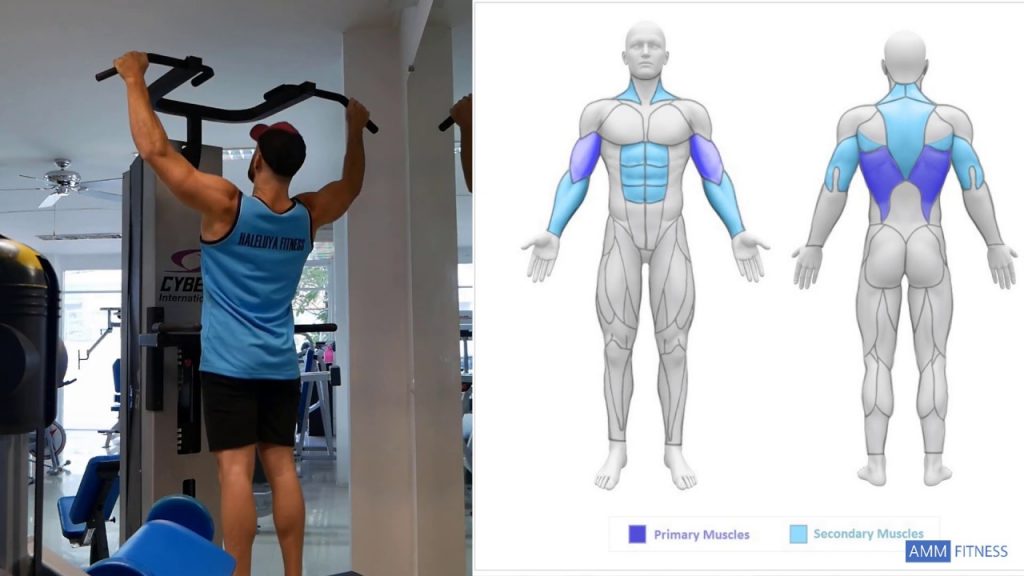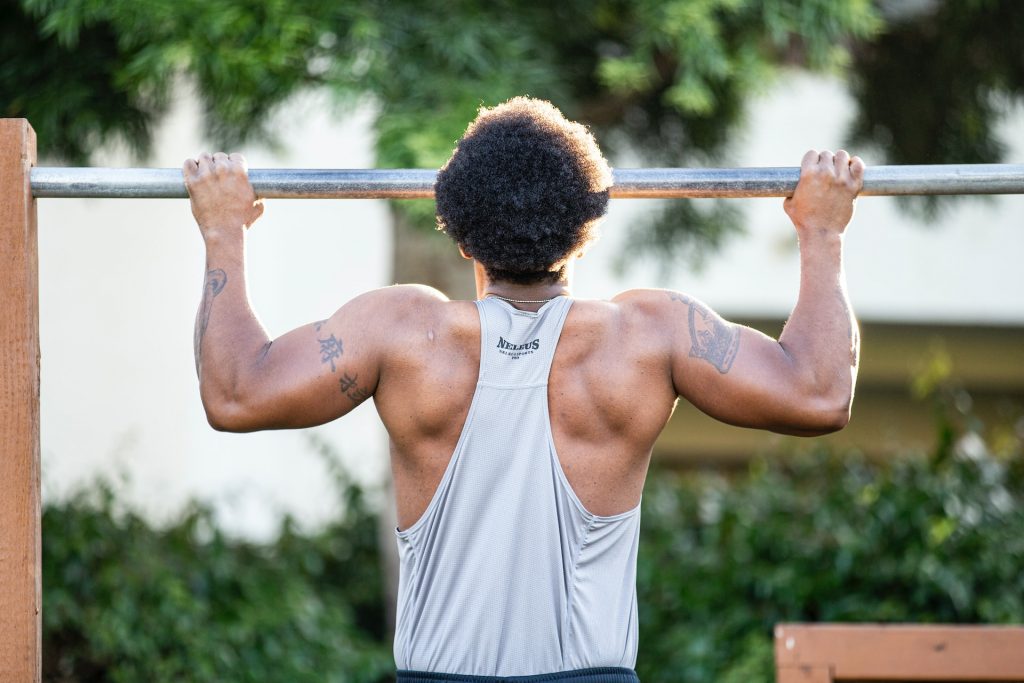The wide-grip pull up is an upper-body strengthening exercise that targets your lats whilst working on the back, biceps, shoulders, and chest. It also works the core muscles.
Performing a pull up is often a challenge for beginners and even experienced athletes. The wide-grip pull up is harder to perform than a standard pull up because your hands will be further apart from the centre of your body which makes the exercise the more difficult.
The wide grip pull-up increases strength, mobility, and muscle mass. Particularly in your lats and traps. The lats are what influences back width and form the “V” in the upper back.
How To Do A Wide Grip Pull Up
Here are the steps to do the wide grip pull up:
- start by standing in front of a pull up bar or a pull up station
- Grab the bar using an overhand grip, with hands spread wider than shoulder width
- Hang from the bar with your chest pushed out
- Take a deep breath and then use your back and arms to pull yourself up
- Bring your elbows in towards your side as you travel upwards
- Breathe out as you perform this movement
- Once your collarbone is in line with the bar, pause, and then slowly lower yourself back down.
- Stop just before your arms are fully extended, and repeat the movement
Wide Grip Pull Ups Muscles Worked
During the wide grip up, the following muscles are activated:
- Latissimus Dorsi
- Trapezius
- Abdominals
- Thoracic erector spinae
- Pectorals
- Rhomboids
- Infraspinatus
- Teres minor
- External obliques
- Deltoids
- Biceps
- Brachioradialis
- Brachialis
The primary muscle used during a wide grip pull-up will be the lats. The lats are a large flat muscle that stretches to both sides of the body. This is the muscle that creates the ‘V’ taper look from the back.
Through the process of a pull-up, the lats are involved by pulling on the upper arms pulling them closer into the body. This is what allows your body to rise up towards the pull-up bar. The wider your grip gets, the more the lats get activated. This also happens because of the shoulders.

Your elbows are able to move inward towards the side of your torso and engage the lats because the shoulders create a greater degree of adduction allowing this to happen.
The biceps will be another of the key muscles used in a wide grip pull-up. Any pulling motion will involve a lot of bicep recruitment. With a wide grip pull up, however, there won’t be as much bicep recruitment compared to a supinated, or close grip chin up. From the starting, hanging position, the biceps need to contract as you lift your weight upwards. But as your body rises, the resistance transfers into the lats activating them more as you continue to pull upward.
Your abdominal muscles are also activated during a pull up, and are an integral part of core stability as you rise and lower yourself back down.
Another key muscle used during wide-grip pull-ups is the trapezius muscles. The trapezius is a kite-shaped muscle that is on the lats but more near the middle and upper back running up the neck. The trapezius muscle is used during vertical pulling movements and they – along with the latissimus dorsi – are the main muscles taking the load through the pull-up.
You might not think of the pectoral muscles being used during a pull-up, but they play an important role. The pectoralis major helps assist the lats while pulling up. These muscles are working together by assisting your upper arms to allow them to pull to the body and the lats.
A 2010 study found that the pectoralis major and lower trapezius are the first two muscles to be activated during a pull up.
The teres major plays an important role in a pull-up. This muscle sits above the latissimus dorsi and attaches to the scapula as well as the humerus in your arm. The teres major works together with the infraspinatus, and teres minor throughout the pull-up. The infraspinatus muscle is one that runs along your entire upper back and then stretches to the upper arms.
The teres minor is below that and it sits on top of the teres major. These three muscles are all activated at the same time to assist in pulling your body upward and are still active during the concentric phase downward. The teres minor, specifically, is important for your shoulder flexion. The teres minor is a rotator cuff muscle and is important during a pull up as it helps assist in external rotation and shoulder flexion.
Wide Grip Pull Ups Benefits
- Targets multiple muscle groups
- Increases strength to perform other movements
- Improves core strength
- Improves forearm and handgrip strength
- Can be performed nearly anywhere
The wide grip pull-up is a challenging exercise but one that can build significant strength and muscle. This motion is better at recruiting the latissimus dorsi and also involves the shoulders along with the back. The wide grip pull-up is also a full upper body exercise as it works the biceps, chest, and core.
Wide Grip Pull Up Tips

These are a much tougher exercise than regular pull-ups so you want to make sure you can perform at least 6 to 8 regular ones.
Performing assisted wide-grip pull-ups or negative pull ups can also help you build up more strength to perform them on your own.
To make sure you’re using the right form on the wide-grip pull-ups, you want to have your hands positioned wider than usual. When hanging, your arms should form a ‘Y’ in relation to your upper body. You want to make sure your thumbs are pointing towards each other when gripping the bar.
As long as your hands are wider than your body, you should be in a good position. This will engage the lats much more than traditional pull-ups because of this wider grip.
- Refrain from hyper-extending your neck by keeping your head straight and in line with the back and spine. Squeeze your glutes and brace your abs also to avoid overextending the lumbar spine.
- You may want to only do a few reps if you’re just starting out. However, if you’re having difficulty completing your first pull up, try a wide grip pull up machine or practice doing a negative pull up.
- You can also use a weight-assisted pull-up machine, but make sure you’re comfortable with the weight. You can adjust the weights as performing the pull up becomes easier.
- When you can pull up your body weight, you can move on to a wide grip pull up on the bar.
Wide Grip Pull Ups vs Close Grip Pull Ups
The main difference between wide grip pull ups and close grip pull ups is the amount of lat activation, and the strain that is placed on the rear delt muscles. Close grip pull ups are much more suitable for beginners or for people with mobility issues.
Wide grip pull ups are great for people who are experienced at performing regular pull ups and want to increase the difficulty without adding more resistance or volume to the workout.
If your goal is hypertrophy, then close grip pull ups may be a better option as you should be able to perform more reps, and they provide a greater range of motion. However, if your goal is to specifically target the lats more then wide grip pull ups are the best option.
What Are The Alternatives to Wide Grip Pull Ups?
If you don’t have access to a pull-up bar but have a barbell, you can do wide grip inverted rows. This is best done with the bar placed in a lower rack. You will start sitting on the ground underneath the rack with your legs out in front of you. You will place your hands on the bar with a grip that is just outside shoulder-width – or the positing that you would be grasping a pull-up bar. The motion will be similar to a wide grip pull up and you want to extend your legs out in front of you so that only your heels touch the ground.
The focus will be on keeping the elbows tight to the body and driving them back behind you as you pull upward. You want to pause at the top where your chest should be touching the bar. Focus on contracting your lats and imagine there is a pole between your shoulder blades that you are trying to squeeze them around. Lower back down under control to get a full extension.
Another version of this involves lifting one leg in the air while you go through the motion so that you only have one heel in contact with the ground. This will create some more resistance and really activate the muscles in the back.
Lat pull-downs will be a classic wide grip pull up alternative. These serve people who have trouble doing multiple pull-ups, but still want to engage those muscles. With lat pulldowns, you have more control over the resistance, and can focus on properly engaging the muscles of the back.
